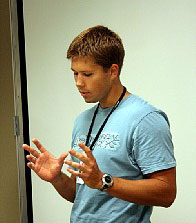
Handy Links
SLAC News Center
SLAC Today
- Subscribe
- Archives: Feb 2006-May 20, 2011
- Archives: May 23, 2011 and later
- Submit Feedback or Story Ideas
- About SLAC Today
SLAC News
Lab News
- Interactions
- Lightsources.org
- ILC NewsLine
- Int'l Science Grid This Week
- Fermilab Today
- Berkeley Lab News
- @brookhaven TODAY
- DOE Pulse
- CERN Courier
- DESY inForm
- US / LHC
SLAC Links
- Emergency
- Safety
- Policy Repository
- Site Entry Form

- Site Maps
- M & O Review
- Computing Status & Calendar
- SLAC Colloquium
- SLACspeak
- SLACspace
- SLAC Logo
- Café Menu
- Flea Market
- Web E-mail
- Marguerite Shuttle
- Discount Commuter Passes
-
Award Reporting Form
- SPIRES
- SciDoc
- Activity Groups
- Library
Stanford
Around the Bay
Lance Simms: Observing the Universe from Earth and from Space
 On July 20, 1969, the world heard Neil Armstrong say, "That's one small step for man; one giant leap for mankind," as he and fellow astronaut Buzz Aldrin took the first human steps on the moon. SLAC research assistant Lance Simms was not yet born at the time, but the words echoed just as clearly when he experienced this epic moment in human history at an IMAX theater as a youngster.
On July 20, 1969, the world heard Neil Armstrong say, "That's one small step for man; one giant leap for mankind," as he and fellow astronaut Buzz Aldrin took the first human steps on the moon. SLAC research assistant Lance Simms was not yet born at the time, but the words echoed just as clearly when he experienced this epic moment in human history at an IMAX theater as a youngster.
Simms remembers that at the time, Armstrong seemed like Superman. "When I saw him get out of the lunar module and speak his famous words," Simms said. "I got goose bumps all over."
The IMAX feature discussing research and adventure in outer space also showed the earth rising from behind the moon, another spectacle Simms says has stuck with him ever since. "I was completely awestruck when I saw the earth rise from the vantage point of the moon in that movie," he says, "and I remember feeling that I had to go there and see that same thing for myself."
At the tender age of seven, then, Simms determined he would become an astronaut—a dream he is now one step closer to fulfilling. The Stanford graduate student in Applied Physics recently submitted an application to NASA, seeking to become part of its next class of space explorers; he is now waiting to hear if he has made the administration's cut.
"Once we get to another star, or at least outside of our solar system, I think it will completely change our understanding of the universe," he says, "and I really want to become an astronaut because there is just so much we do not know and can't know until we send people out to explore."
Permanently grounded until he receives an invitation from the nation's space administration to become an astronaut, Simms currently satisfies his explorer's spirit through the eyepiece of a telescope.
"Right now astronomy is the best thing I can do to catch new glimpses of what is out there," he says, "and you just never know, you might be taking a picture of something no one has ever seen."
Simms came to SLAC in 2004 through Stanford University's graduate program in applied physics. The program offers a rotation in which incoming students can work in a different laboratory in each academic quarter of their first year; during his first quarter of graduate school, Simms was paired with the Kavli Institute for Particle Astrophysics and Cosmology's Steve Kahn, who explained to him that as his student, he could work on detectors for telescopes.
A little over three years have passed since Simms and Kahn first began working together, and in that time Simms has begun to dream of helping to build a telescope on the moon. Such an instrument would give astronomers the best of both the ground and space observatories; being built on solid ground would support the large structure of the telescope, and, he explains, existing in a place without an atmosphere would eliminate the inconvenience astronomers face during poor weather as well as the image degradation caused by atmospheric turbulence.
"I'd really love to be a part of the team that raises the money to build this telescope," Simms says, "and to even help build it as an astronaut."
—Ashley Yeager, SLAC Today, February 6, 2008
Above image: Lance Simms discusses telescopes at last year's SLAC Kids Day.